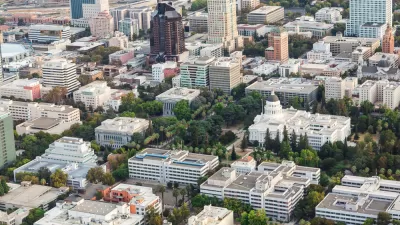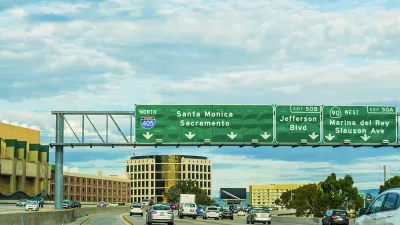The 0.77 percent growth rate comes mostly from increased births, reports the California Department of Finance. The Census Bureau estimated the population increase at 20 percent less for the same time period: July 1, 2016 to July 1, 2017.
While net domestic migration, a measure of residents moving to California from other states minus those leaving for other states, remained negative, as it has since 2000, the number was lower than in 2016. "The net number of people who left for other states dropped from 164,000 in 2016 to 105,000 this year," reports Melody Gutierrez for the San Francisco Chronicle on Dec. 21. Only Riverside County, the fourth most populous county in the state after Los Angeles, San Diego, and Riverside, had positive domestic migration.
Net migration, on the other hand, which includes movement to and from abroad as well as domestically, added 80,000 people, accounting tor 27 percent of the state's population growth, with the remainder coming from natural increase, i.e., births minus deaths.
Residents leaving the Bay Area have been getting wealthier due in part to the region's exorbitant housing market, which also discourages lower-income people from moving to the nine-county region.
The fastest growing counties were inland, in the Central Valley or Inland Empire, according to to the California Department of Finance new release [pdf] on Dec. 21. The department is mandated by the state constitution to obtain the demographic data.
Placer, Stanislaus, Merced, San Joaquin, and Riverside counties had the largest percentage increases in population, each growing by 1.28 percent or more
The increase in population was greater than last year's addition of 295,000 people, a .75 percent increase.
The birth rate dropped to 12.3 births per 1,000 population, the fourth lowest since data collection began in 1905, from 12.42 births per 1,000 last year and 13.8 births per 1,000 population in 2010.
Conflicting data from Census Bureau
The U.S. Census Bureau released population data a day earlier, Dec. 20, highlighting Idaho as the nation's fastest growing state at 2.2 percent.
According to the Census report, the Golden State gained 240,177 from July 1, 2016 to July 1, 2017, or 60,823 fewer people than the state estimate, amounting to a 0.61 percent growth rate. Considering the nation as a whole grew by an average of 0.72 percent last year, adding 2.3 million people, it's important to use the Census data, not state data when comparing California to the rest of the country. The current population of the U.S. is about 326.5 million.
While California is the most populous state, 39.53 million people on July 1 according to the Census (70,000 higher than state's figure), both Texas and Florida, the nation's second and third most populous states, added significantly more residents last year, with 399,734 and 327,811, respectively.
FULL STORY: Politics California’s population: 20 million in 1970, nearly 40 million now

Alabama: Trump Terminates Settlements for Black Communities Harmed By Raw Sewage
Trump deemed the landmark civil rights agreement “illegal DEI and environmental justice policy.”

Study: Maui’s Plan to Convert Vacation Rentals to Long-Term Housing Could Cause Nearly $1 Billion Economic Loss
The plan would reduce visitor accommodation by 25% resulting in 1,900 jobs lost.

Planetizen Federal Action Tracker
A weekly monitor of how Trump’s orders and actions are impacting planners and planning in America.

Federal Homelessness Agency Places Entire Staff on Leave
The U.S. Interagency Council on Homelessness is the only federal agency dedicated to preventing and ending homelessness.

Restoring Northern India’s Himalayan ‘Water Temples’
Thousands of centuries-old buildings protect the region’s natural springs and serve as community wells and gathering places.

Milwaukee to Double Bike Share Stations
Bublr Bikes, one of the nation’s most successful, will add 500 new e-bikes to its system.
Urban Design for Planners 1: Software Tools
This six-course series explores essential urban design concepts using open source software and equips planners with the tools they need to participate fully in the urban design process.
Planning for Universal Design
Learn the tools for implementing Universal Design in planning regulations.
Caltrans
Smith Gee Studio
Institute for Housing and Urban Development Studies (IHS)
City of Grandview
Harvard GSD Executive Education
Toledo-Lucas County Plan Commissions
Salt Lake City
NYU Wagner Graduate School of Public Service





























